 Category: Wine
Category: Wine
You Never Forget Your First Crush
Scott Elliff of DuCard Vineyards once told me that harvest was a joyous time, the culmination of a year’s hard labor tending the vines. And on September 21, after four years of planning, preparation, and hard work, we experienced that joy in our own vineyard, picking grapes from the vines we had planted with our own hands and nurtured like our own children. If I’m at this ten years from now, I’m sure I’ll still find joy in the harvest, but I doubt that it will be anything like the euphoria I felt as we picked those first Cab Franc grapes this year.
To recap a bit, the Vineyard Goddess and I began this adventure some four years ago. We took classes on viticulture and enology at Piedmont Virginia Community College, did lots of research on our own, debated which clones and which rootstocks to order, and finally planted our vineyard in the (very) early spring of 2012. Since then, we’ve invested a lot of sweat, a couple of tears and even a little blood (I snipped my finger with the pruning snips during the harvest) in bringing those vines to the point where they were ready to produce a crop of grapes worthy of picking.
And, oh my God – did those vines ever produce!
The Cab Franc and the Petit Verdot were absolutely magnificent: nearly perfect fruit that proved irresistible to the bees that laid siege to those rows of vines. The Merlot, for whatever reason, fell behind. I had thought we’d pick the Merlot first among the reds, and by all rights we should have. But after accumulating sugar at a rapid pace, the Merlot vines just shut down. We picked them October 5, and I’m hoping for the best.
The Viognier was disappointing. Virginia-grown Viognier makes a wonderful wine, but it’s hard to grow. For some reason it’s subject to something called primary bud abortion, and I guess our vines experienced that phenomenon, because the Viognier was the least fruitful of all our varieties. The grapes looked lovely, but I had expected about 100 pounds or so, and we got about 20. Other vineyards around the Commonwealth had the same experience, though on a totally different scale (the difference between tons and tens of pounds).
The last of our varietals is Petit Manseng, and those grapes looked beautiful when we harvested them two weekends ago. We want to make a desert wine from them, and so we let them hang a bit longer than we might have. We had hoped they would accumulate a little more sugar and lose a little more acid. If we had known we were in for some pretty significant rain the week prior, we might have chosen differently, but weekend vintners like us have to make some tough decisions and then live with them. As it turned out, we didn’t get the extra sugar or the lower acidity. We’ll work with it.
But getting back to where I started, there are some things you never forget. I can still remember the first crushes of my life – the first time I saw the Vineyard Goddess in the newsroom of our college newspaper, the first book I really fell in love with (thank you, James Joyce), the first time I saw my children, and the first time I saw Venice, walking out from the train station on a beautiful sunlight day to see the Grand Canal sparkling with life. Some things you just never forget.
And so, I don’t want to get too sentimental about this, but when we had finished picking the Cab Franc on that beautiful September morning, the VG and I hugged and felt a sense of euphoria. All those years, all that sweat, and all that worry behind us; now we had the fruit of our labor in front of us, collected in a dozen five-gallon Home Depot buckets. It was one of the most wonderful moments of my life.
A little detail: we had gotten up at first light that morning to pick, and we finished before the sun hit the vines. The early morning, especially this time of the year, is cool, and you want the grapes to hit the crush pad (i.e., our driveway in Fairfax) cool. The crush, by the way, is the term applied to the harvest and the process of preparing the grapes for fermentation.
As we picked, we stored buckets in a refrigerator we had purchased just for this task. With the shelves removed, we could fit six buckets, stacked on top of each other, separated by the shelves I had pulled out and repurposed. As we brought more grapes up from the vineyard, we pulled the buckets from the frig and dumped them into a 120 quart cooler from Costco. When it was filled, we pulled out smaller coolers. The grapes were cool to the touch right up to the crush, and the must came in at around 60 degrees or lower.
As it turned out, picking the grapes was the easy part. I had done a lot of research and reading, a lot of planning, and a lot of online shopping for the equipment and supplies we would need. But for all that work, when it got down to actually making the wine, I found myself in the weeks before the harvest feeling a bit lost.
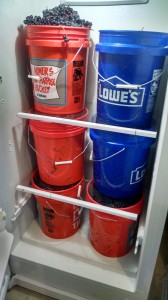
A refrigerator full of wine grapes — this is about half the load of Cab Franc. We dumped these into the cooler and refilled the frig.
So, before we picked the first grapes, I started making a cheat sheet. It went something like this:
First, add sulphur at a rate of 50 parts per million (.33 grams per gallon), which kills off unwanted natural yeasts and protects the must (the mix of juice, skins, seeds, and stems that will turn into wine) during those vulnerable hours before fermentation begins. Next, check the brix, pH and TA (titratable acidity) of the must (add a dozen steps here). Rehydrate the yeast (add a half-dozen steps here). And so on. (Add dozens and dozens of individual steps.) And for all that, I found myself furiously reading the instructions (again) on my lab test equipment to be sure I knew how to test the TA, and reading other literature on hydrating and preparing yeast.
When we arrived back in Fairfax, we started with the easy stuff: the sorting table. We had purchased a folding table, which turned out to be the perfect place for the family and friends to gather around for some work and talk. Kind of like what I imagine a quilting bee was like a century or so ago. We pulled some chairs around the table, and the VG and I, plus daughter Kate and a couple of neighbors, sorted the grapes. That’s easy and straightforward, but it’s also very time consuming.
The fruit was amazing, so we didn’t throw away very much at all. Mostly, we were looking for MOG – matter other than grapes. We found the occasional spider web (with the spider, in most cases, which elicited a few screams), and some extra leaves and such. But the fruit that went into the crusher was just about perfect.
The crusher-destemmer was way more of a machine than we really needed. It crushed the fruit faster than we could drop it in, and we were finished with that part of the process in maybe ten minutes. Honestly, cleaning it took way longer than the actual crushing. But I’m still glad I bought it. More on that in another post.
In the end, the Cab Franc yielded some 20 gallons of must – juice, grape skins, seeds and some stems that fell through the destemmer. As luck would have it, I had a 20 gallon bucket on hand to catch it all. Again, we’re still on the easy part.
I weighed the sulphur (potassium metabisulphite), mixed it with distilled water and added it to the must. And then, I spent hours measuring the pH and TA and brix, deciding whether to adjust the sugar level or acidity (I decided not to), and preparing to pitch the yeast. And in between, I cleaned out the crusher, the extra buckets, and everything else I used in the process. Not to mention sanitizing everything that came into contact with the must.
I have always used potassium metabisulphite for sanitizing, but now, with my own grapes at stake, I worried a bit. I had used sulphites at 50 ppm to protect the must, and the mix for the sanitizing solution was much stronger than 50ppm. So I decided to go with Star San, an acid-based sanitizer that requires no rinsing afterward. Pretty much every bone in my body was calling for sulphur, but I resisted.
It was some day. We were in the vineyard at about 7 a.m., and it was close to 10 before I pitched the yeast, which started the fermentation (Not right away mind you; no, the yeast played with me, waiting days before they actually began to ferment the must).
Much of the time spent that day involved nothing more than anxiety – wanting to get everything just right and worrying that I was getting everything just wrong – but another part of it was the actual physical labor involved. By the time the day was over, I was exhausted, and the memory of hugging the Vineyard Goddess at the end of the harvest was just that – a distant memory.
Well, I suppose in the end, it’s like dating the first girl you had a crush on – the hopes, the anxiety, the desire to get everything just right, the certainty that you have gotten everything totally wrong, and the physical exhaustion that comes from working so hard.
But I’m hoping this crush is like the time I laid eyes on the Vineyard Goddess for the first time. If this crush is as perfect as that one, we’ll have a wine for the ages.
Tempranillo, Part IV: Wine Faults and Me
It’s been about a year since I bottled my Tempranillo, and so I thought it was time to give it a try. This is a wine I had great hopes for: I had participated in a tasting at WineMaker magazine’s conference last year, and the wine had received reviews that ranged from the merely positive to almost glowing. And it had been in the bottle for only 35 days – hardly over bottle shock.
So you can imagine my surprise when, almost immediately after opening the bottle, I detected an odor – not an aroma, mind you, but an odor. I thought perhaps that it was just one of those things – a little, well, I don’t know what. I just thought it would pass.
It didn’t.
I poured the wine, swirled it vigorously, and sniffed. It stunk.
And then I swirled the glass much longer and even more vigorously, and sniffed again. It still stunk.
Well, I thought, perhaps it’s one of those wines with barnyard or some such aromas but wonderful tastes. I think there are such things. Well, actually, I have no idea. I was just hoping.
But if there are such things, they didn’t account for this bottle’s problems. It tasted just awful. I suppose that if I were a still a college student, more interested in the alcohol content than the aromas and taste of the wine, I could have choked it down. I’m sure I drank much worse in those days. (Remember Ripple? Boone’s Farm?)
But today? No, no way. I would say that in an even more emphatic way, but this is a family friendly blog and such language is not permitted.
I can’t begin to tell you how depressed I was beginning to feel. This was my prize wine, the star of all the wines I have made, and I had outrageously outsized expectations for it. And yet, the evidence was clear. It stunk.
That was especially bad news now, since I’m getting ready for our first grape harvest in a couple of months. If my very best effort with a kit wine had turned out so badly, how could I possibly expect to do well with fresh fruit, which is a much more complicated process.
I decided I would give the bottle another day, so I set it aside and opened a California Pinot Noir to drink instead.
The next night, I opened the Tempranillo again, more in fear than anticipation, and quickly realized my instincts were right. It still stunk. Probably as much as the first night, maybe more. Now I was really depressed.
But a day later, on the way into work, I suddenly realized that I recognized that bottle’s foul smell. TCA taint. The wine was corked. I was sure of it.
A corked bottle is one that has been tainted by 2,4,6-Trichloroanisole, or TCA for short. It’s usually described as smelling like a damp basement or wet socks left too long in the hamper. Over the years, I’ve read that something like one to five bottles out of every hundred suffer from TCA taint. I actually find that hard to believe, since I rarely encounter one. In fact, I have to say that the only reason I recognized this flaw as TCA taint is because I took a class last year on wine faults and had an opportunity to sniff and taste a corked wine.
Even so, I clearly wasn’t prepared to believe that a wine I had made and bottled could possibly be corked. The idea hadn’t even entered my head.
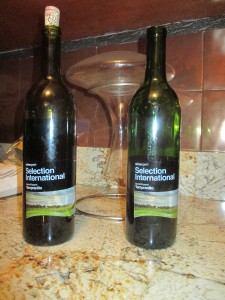
A tale of two bottles. They came out of the same tank, made in exactly the same way, but one was a joy to drink, and the other sucked!
But this evening, energized by this flash of insight, I pulled out another bottle of the same Tempranillo to taste. I have to say, I was a bit concerned – clearly, my bottling technique could use some work because there was at least an extra inch of air in the neck of the bottle. Well, that’s why I’m working with kits: trying to get all the mistakes out of my system.
Opening the new bottle, I was prepared for the worst. But after pulling the cork, I sniffed the wine from the bottle and was thrilled – no sign of TCA! I poured a half-glass, swirled, sniffed and was elated. The wine was definitely not corked. But was it good?
I tasted it, and wanted to shout. Yes, indeed, it was good. Soft tannins, big fruit, nice acidity. I’m guessing that Robert Parker won’t be including it in the next issue of the Wine Advocate, but whether it warrants a score of 92 or 82, it was good – a lovely, drinkable wine.
So, I’m somewhat more confident about my prospects as a winemaker. And, as a bonus, I have another two cases of good wine that I don’t have to pour down the drain.
A final word. I think everyone who loves wine should feel comfortable returning a bottle and telling a waiter at a restaurant or the manager at a wine store that the wine is flawed. I’ve done this perhaps a half-dozen times in my life. And at Total Wines, for example, they never bat an eye. They take the bottle and invite me to get another. And I suppose they would offer me a refund, but I’ve never asked. It seems more fair to get another bottle of the same wine.
And that’s the point. If you buy a wine, you should be prepared to deal with it. If you decide it’s not to your taste, ok, you won’t be buying it again. But you shouldn’t think you’re entitle to a refund because you like soft tannins and the wine you bought needs a couple of years in the cellar. Or because you bought a white that was aged in oak and you suddenly realize that you prefer whites aged in stainless.
But a genuine fault is different. If the wine is corked or oxidized, if it has severe Brettanomyces, then you should feel comfortable in sending in back. It’s not always an easy call. It took me two days to realize my wine was corked. And Brettanomyces? Well, that’s a touchy subject. A little can add some character, more than that can ruin the wine.
So, I guess the best advice I can offer is to trust your instincts, but be reasonable. And over time, if you taste enough wine, you’ll learn to recognize common wine faults. Which, thank God, are few and far between these days.
If we’re winter pruning, then Spring must be close
Maintaining a vineyard is a year-round enterprise. Even in the winter, after the vines go into a dormant state, there’s work to be done. In fact, dormant winter pruning is among the most time-consuming work of the year, and some of the most important as well, since it involves decisions that will affect not just the coming season’s growth, but the year after as well.
Most of the objectives of dormant pruning fall under the heading of “balance.” Vines will grow just fine on their own, with no pruning at all, but most of their energy will go toward producing shoots and leaves, rather than grapes. Absent any intervention, the vines will continue to grow skyward for so long as they can find support. The whole purpose of a trellis system and the pruning decisions that go with it are to force the vine to direct its energy toward the production of high-quality fruit rather than vegetative growth.
So we’re looking for balance as we decide which shoots and how many buds to retain. Prune away too much and the vine will be undercropped, producing less fruit than it can reasonably support. Prune away too little and it will be overcropped, producing a profusion of leaves and shoots, as well as an abundance of fruit that is destined to be of low quality.
During the growing season, we’ll drop some fruit from the vine, again to direct energy toward the remaining clusters in the hopes of producing more concentrated and higher-quality grapes. But the first decisions we make that will determine the quantity and quality of the season’s fruit are those made in the dead of winter.
Which is to say, when it’s cold outside. Really, really cold. Not to mention snowing every few days or so. (Or maybe it just seemed that way this winter.) Which is one of the reasons we’ve put off pruning.
The other, more noble reason for delaying our pruning, has to do with timing. It’s better not to prune too early in the season – the untouched vines will survive a cold spell much better than those that have been pruned back, and by waiting, you’ll have more options in the case of a late freeze that damages buds and shoots.
It’s helpful to be able to assess the vine late in the winter for cold injury before deciding which canes to remove and which few to retain. In our little hobby vineyard, we have the luxury of delaying for almost as long as we want to start dormant pruning. Commercial vineyards that have acres of vines to prune, don’t have that luxury. They need to start early enough to be able to finish the job before budbreak. But many vineyards employ a technique of double pruning, going through once early in the winter to trim away the shoots they know won’t be used, and returning later to finish up the job.
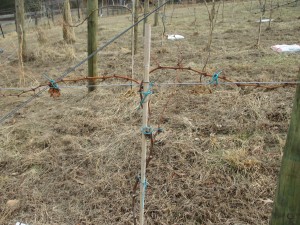
This cane-pruned vine is finished on the left arm, only partly done on the right. Click on the picture for a better view.
Our vines are all trained to a trellis system known as vertical shoot positioning, of VSP, and we have adopted a pruning method known as cane pruning. In cane pruning, most of the previous year’s growth is pruned away, and two one-year old shoots, which have now achieved the status of canes, are retained and trained in either direction along the bottom, or fruiting wire. These canes – the one-year old wood – will give rise to new shoots this summer, and these new shoots are the part of the vine that will bear fruit.
At the same time, we’ll be looking for renewal spurs below this year’s fruiting canes. These will be pruned back to one or two buds to provide the fruiting canes for the following year.
I’ve taken a class or two on pruning, and I’ve done lots of reading and studied more videos on the Internet than I can count. So, of course, I should be an expert. And in theory I am. I know a lot about the why’s and how’s of pruning. But the actual pruning – the time when you come face to face with a vine and decide what to lop off and what to keep – that’s a whole different story. I still remember my first pruning session. I was sure that I was going to destroy the vine, and I stared at it for what seemed like hours before I worked up the nerve to make that initial cut. I’ve gotten a little more confident, but only a little. I still spend way too much time on each vine. Fortunately, we only have 230 vines now, so I can get away with it.
When the Vineyard Goddess and I got out a few weeks ago – and yes, we chose a weekend when the temperatures were in the 60s – we realized that we had not maintained the vines as well as we should have in the previous year. No neglect, just the kinds of mistakes you make early on. A number of the vines were just fine, but others lacked the kind of year-old shoots we were looking for to train to the cordon wire.
So, we made some adjustments. On the vines that had perfect one-year old shoots, we cut away everything else and tied these canes down. On those that didn’t, we resorted to a different pruning method called spur or cordon pruning.
In spur pruning, a cordon is tied down to the wire and used year after year. The shoots from the previous year are pruned down to two buds, which will give rise to fruitful wood for the current season. It’s more like a haircut, and most people would say it’s a far easier method of pruning than cane pruning. And it works well for at least the first decade. At some point, however, these cordons grow thick from age and produce fewer spurs. Moreover, they’re more prone to disease. It’s the same with people. The older you get, the more opportunity your body has to develop diseases.
Which method is better? Well, they each have advantages and disadvantages. Jim Law, founder and owner of Linden Vineyards, said he started with spur pruning, which worked well for years, but eventually moved to cane pruning, after the disadvantages – disease in particular – began to outweigh the advantages.
Our thought, however, is that we’ll spur prunes those vines that need it this year, while leaving some buds that we hope will give rise to canes that can be trained to the wire in 2015. And while I remain hopeful that our vines will produce some wonderful fruit thisyear for making wine, I am confident that we’ll do even better next year and better still in each of the succeeding years. After all, this is a learning experience, and Lord knows, we’re learning.
A Holiday Book List for Wine Lovers
With the holiday season upon us, I can’t think of a better gift for someone you love (or even someone you don’t like all that much, but for some reason are obligated to buy a gift for) , than a book about wine, save perhaps for a bottle of the actual stuff. In the time since I started writing this blog, I’ve read a fair number of books on this subject, many of them about the process of growing grapes and turning them into wine, others on the joys of drinking wine, and still others on some topical issue, such as the touchy subject of natural wine.
With that in mind, I thought I’d list a few books that might make a nice gift for a friend or stocking-stuffer (yes, I know, that would be some big stocking – but you can just leave it under the tree). Most of these are books I’ve read and enjoyed, and some are volumes that I’ve put on my own list. Among those in the category of books I’ve loved, I’ve either reviewed them or have plans (and yes, I have more plans than time) to write a review on Project Sunlight. So, stay tuned. Meanwhile, here’s the list:
Some Books I’ve Loved
Of all the books I’ve read about wine, I’ve enjoyed none more than Authentic Wine by Jamie Goode and Sam Harrop MW (Master of Wine). 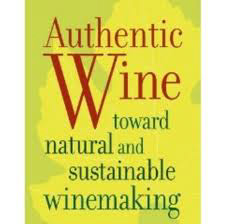 The book’s subtitle, Toward Natural and Sustainable Winemaking, gives a broad hint about where it’s heading, but one of the most appealing things about the book is its balance. The authors clearly respect the idea of natural wine and sustainable viticultural practices, but their first priority appears to be good wine, and they understand that a business isn’t sustainable if it isn’t profitable. Authentic Wine falls neatly into two parts, one dealing with viticulture and the second focusing on winemaking. I’ve read this book twice (you’d think after that I’d have taken the time to write at least a short review), and I’ll will probably read it yet one more time. They write intelligently and lucidly about a variety of current issues in the wine world, from reduction to the difference between natural and cultured yeasts to the trend toward riper fruit and higher alcohol levels. The get into the science and technical issues, but the writing is accessible and easy to follow. That’s quite a rare feat, and one of the reasons I’m so high on Jamie Goode.
The book’s subtitle, Toward Natural and Sustainable Winemaking, gives a broad hint about where it’s heading, but one of the most appealing things about the book is its balance. The authors clearly respect the idea of natural wine and sustainable viticultural practices, but their first priority appears to be good wine, and they understand that a business isn’t sustainable if it isn’t profitable. Authentic Wine falls neatly into two parts, one dealing with viticulture and the second focusing on winemaking. I’ve read this book twice (you’d think after that I’d have taken the time to write at least a short review), and I’ll will probably read it yet one more time. They write intelligently and lucidly about a variety of current issues in the wine world, from reduction to the difference between natural and cultured yeasts to the trend toward riper fruit and higher alcohol levels. The get into the science and technical issues, but the writing is accessible and easy to follow. That’s quite a rare feat, and one of the reasons I’m so high on Jamie Goode.
Also high on my list is Mike Veseth’s wonderful discussion of current wine industry trends, Wine Wars. (Reviewed March 28, 2013) Subtitled, “The Curse of the Blue Nun, the 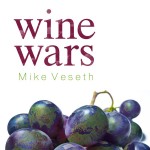 Miracle of Two-Buck Chuck, and the Revenge of the Terrorists,” this book ranges over a great deal of history to put some of the trends into context, and provides a lot of insight into some of the things, like Trader Joe’s and Costco, that are right in front of our eyes. Could a two-dollar (somewhat more outside of California) bottle of wine have succeeded if it had been sold anywhere else but at Trader Joe’s? In a world in which quality is often equated to price, it might not have worked at a retailer that had not already won the trust of its customers. And yet, in Europe, some perfectly drinkable wines sell (or at least sold recently) for a Euro a liter, making it effectively One-Buck Chuck. Mr. Veseth writes with the authority of the wine economist (a profession I did not know existed prior to reading this book), he is, and it’s clear that he not only knows a lot about wine, but that he loves it as well. The fact that his prose is both clear and engaging is just a bonus. Continue Reading–>
Miracle of Two-Buck Chuck, and the Revenge of the Terrorists,” this book ranges over a great deal of history to put some of the trends into context, and provides a lot of insight into some of the things, like Trader Joe’s and Costco, that are right in front of our eyes. Could a two-dollar (somewhat more outside of California) bottle of wine have succeeded if it had been sold anywhere else but at Trader Joe’s? In a world in which quality is often equated to price, it might not have worked at a retailer that had not already won the trust of its customers. And yet, in Europe, some perfectly drinkable wines sell (or at least sold recently) for a Euro a liter, making it effectively One-Buck Chuck. Mr. Veseth writes with the authority of the wine economist (a profession I did not know existed prior to reading this book), he is, and it’s clear that he not only knows a lot about wine, but that he loves it as well. The fact that his prose is both clear and engaging is just a bonus. Continue Reading–>
Tempranillo, Part III
On the eve of our departure for WineMaker magazine’s annual conference, hosted in Monterrey, California, this year, I expressed some regret to the Vineyard Goddess that I didn’t have a bottle of home-made wine to take with me for one of the tasting events. I had bottled my Tempranillo some 35 days earlier, and while it was just past the bottle shock stage, I had not yet tasted it (and it was way too late to try it that night). For all I knew, it was plonk.
“Take it anyhow,” the VG told me. “Take two bottles. We can taste one on the first part of the trip, and if it’s good, you can take the other one to the tasting.”
Sage advice. I packed two, using my newly minted method of wrapping the bottles in bubble wrap (replacing my old method of wrapping them in t-shirts), and told myself we’d taste the first bottle when we arrived in Sedona on the first leg of our journey. As it turned out, I didn’t get to it until we reached the Grand Canyon for the second leg of the trip.
And what a surprise! It wasn’t the vintage of the century, but it was definitely good. I knew I had made some mistakes in the process, especially in the area of temperature control (overheating it at some points, and not keeping it warm enough at others), but it was still a good, solid drinkable wine. So, I felt confident that I could hold my own with the other winemakers, or at least not get ridden out of town on a rail.
The comments were generally favorable. The 100 or so winemakers who gathered for the tasting were seated at round tables of 10, and half the table rotated every ten minutes to be paired with new tasting partners. We tasted each other’s wine and provided feedback. I’d like to say that everyone was totally, if not brutally, honest, but I suspect we were more diplomatic than candid.
So, here are some of the comments:
“Young, but very hearty. As it ages, it will become a very nice wine.” (Oh, yeah, as it ages — someday it will be a decent wine!)
“Good tannins, good acidity, nicely balanced.”
“Good color, very dry. Nice tannins and structure.”
“Crisp acidity, not quite as much fruit as I’d like to see.”
Well, that’s as far as my notes go. Nobody was talking about long finishes or specific kinds of fruit on the nose or palate, but all in all, for a first outing, it wasn’t bad. As I said in a Facebook post, I had walked in with nightmares that my fellow tasters would spit my wine on the floor and then throw me out of the room. It was a relief to see that they all stayed and finished their taste of Bob’s Tempranillo.
Wine Wars: Terroir’s Last Stand?
Reading Wine Wars, Mike Veseth’s superb book about the forces shaping the modern wine industry, brought two memories to mind, one of fairly recent vintage, the other decades old.
I’ll start with the older one, which involves a college night with friends. For reasons that I’m sure made good sense at the time, we decided it would be fun to buy a bottle or two of the cheapest wines we could find on the shelf at a nearby 7-Eleven. I don’t remember exactly what we bought or what I drank, but the names Thunderbird, Boone’s Farm, and Blue Nun spring to mind. I also can’t recall how much we paid for them, but it seems like they must have been a couple of dollars each, in line with the cost of a six-pack of beer in the late 1970s. And, oh yes, I vaguely recall waking up the next morning with a killer hangover.
The more recent memory involves a lunch in Madrid a couple of years ago. On the way 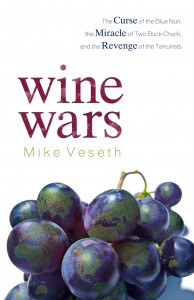 to the Prado museum, we stopped at a nearby restaurant for a quick lunch. I ordered the menu del dia, or menu of the day, a common offering at Spanish restaurants that generally features a soup or salad, an entrée, a desert and a choice of beverages. When I asked about the choice of beverages, I was offered soda of some kind, water, coffee, tea, or wine. Naturally, I asked for red wine, pleasantly surprised, but realistic enough to expect nothing more than a glass of something that would be innocuous at best.
to the Prado museum, we stopped at a nearby restaurant for a quick lunch. I ordered the menu del dia, or menu of the day, a common offering at Spanish restaurants that generally features a soup or salad, an entrée, a desert and a choice of beverages. When I asked about the choice of beverages, I was offered soda of some kind, water, coffee, tea, or wine. Naturally, I asked for red wine, pleasantly surprised, but realistic enough to expect nothing more than a glass of something that would be innocuous at best.
A few minutes later, the waiter brought a bottle to our table, set it down, and said something that I took to mean, “this bottle is all for you.” When I questioned him, he repeated the phrase. And I understood. Yes, it was mine, all mine. The entire bottle.
The meal probably cost 8 or 9 Euros, about $11 or $12 at the current exchange rate, at the bottom end of what I would expect to pay in any major U.S. city for a decent lunch at a nice, but inexpensive restaurant. Two things struck me about that transaction. First was the recognition that back home, the price of the meal would barely have covered a glass of wine, if that, along with a decent course or two of food. But what really surprised me was the casual way they threw in the full bottle. We’re talking wine, after all, not water from the tap.
I wondered off and on in the intervening years how it could be possible to serve a bottle of wine with a meal as though it was nothing more than a cup of bad coffee. Wine Wars gave me some answers.
Mr. Veseth discusses three major trends shaping the world of modern wine: globalization, “the miracle of Two Buck Chuck,” and what he refers to as “the revenge of the terroirists.” Continue Reading–>
Tempranillo, Part II: The Hydrometer Never Lies
I was pretty excited last Monday when I began making six gallons of Tempranillo wine. I thought I had been pretty clever in the way I had gotten the temperature just right before pitching the yeast, and I was pretty confident that things would go well.
And 24 hours after inoculating the unfermented must with yeast, I was pretty sure fermentation was well underway. The airlock was beginning to accumulate carbon dioxide, or CO2, bubbles and there was a fragrance in the air that I have always associated with fermentation. Also, there was a loud hissing sound inside the primary fermenter said there was something alive and growing inside. Yeast is a truly amazing microorganism.
Forty-eight hours in, I was beginning to worry. The airlock wasn’t bubbling up and down in the vigorous way I had expected, and I wondered if the fermentation had become stuck. Or worse, if it had actually been stillborn, and I had only been deluding myself the day before. I punched down the grape skins for a couple of minutes (the grape skins are pushed to the top of the fermentation vessel by the CO2 released during fermentation, and they must be “punched down” daily to ensure proper contact with the must – more on this in a later post) and then checked the temperature.
The results were a bit scary – almost 90 degrees. Apparently the heater I was using was a blunter tool than I had thought. That seemed a bit unjust. The last time I made wine, fermentation took forever, and was briefly stuck because I had let the house get too cold. Now, I had apparently gone too far in the other direction.
On Thursday, I was feeling even worse about the fermentation. I had shut down the heater, and the temperature had dropped to the low eighties.
Better for fermentation, but probably still a bit too hot to re-inoculate. I knew I could get the temperature down, but I wasn’t really sure how to go about reinoculating.
I had packages of two different kinds of yeast: RC212, which was the particular kind of yeast that came with the kit, and EC1118, a champagne yeast that is also supposed to be good for restarting stuck fermentations. I wasn’t sure which to use, whether I should rehydrate the yeast with some of the juice before pitching it, or whether I should get the temperature down first. So, I called the company’s technical support line.
I was using a Winexpert kit, and I can’t begin to say enough about their customer support. I got a real person on the phone in a couple of minutes, and she was terrific. Here’s how the conversation went (picking up after I explained the problem):
She: What was the specific gravity when you pitched the yeast?
Me: 1.082
She: What is it now?
Me: I haven’t checked, but since it doesn’t seem to be fermenting, I assume it’s still right around 1.08.
She: You need to check. Give me your number, and I’ll call you back in ten minutes while you take a reading.
Me: OK.
After about ten minutes, she called back.
Me: I just finished sanitizing the hydrometer and wine thief and I’m just filling the tube (for the hydrometer).
She: OK.
Me: Uh. . . Can this possibly be right? It looks like it’s 1.02.
She: You got it! It’s working.
Me: Uhhhh . . . yes, it is. (but thinking, yes, I am an idiot. . .)
What I learned from her was to rely on the hydrometer, not my visual checks. She was good enough to stay on the phone with me for another five minutes to talk about winemaking and to answer a few more questions about the kit. Honestly, it was one of the best customer support experiences I’ve ever had.
So, I let the wine continue fermenting. Twenty four hours later, the specific gravity was down to 1.011, and the night after that, it was just a hair over 1.000, maybe 1.001. Sunday morning, I’ll check again, and I think it will be time to rack it into a carboy for the secondary fermentation.
Meanwhile, I’m planning to start making a new batch of wine in a week or two, this time Winexpert’s Lodi Ranch 11 Cabernet Sauvignon. And I’ll be relying less on visual observations and more on things I can measure, like temperature, pH, and specific gravity.
After all, your eyes may deceive you, but the hydrometer never lies.
Five Vintages of Cab Franc at Gadino Cellars
As I’ve said before, I believe that Cabernet Franc is Virginia’s signature red grape, even if Petit Verdot iscoming on strong. It is more cold-hardy than Merlot or Cabernet Sauvignon, and it ripens earlier. That’s important in Virginia, which can be prone to early frost, Fall rains, and the occasional harsh winter. And Cab Franc is a wonderful grape on its own. It has softer tannins than Cab Sauv, and while it might not be quite as age-worthy, wines today are being made (and
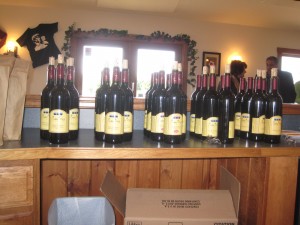
- Five Vintages of Cab Franc waiting to be poured, along with a mystery wine, hidden in brown bags for blind tasting
purchased) for early drinking, not for years in the cellar. Cab Franc will age, of course, but it is also more accessible when young than the more tannic reds. And Cab Franc can be used on its own or as a blend to make wines with great complexity, as the great St. Emilion blend, Cheval Blanc, demonstrates.
Cab Frank is particularly important to my wife, the Vineyard Goddess, and me, because it’s one of three grapes we will be planting this Spring, the other two being Petit Verdot and Viognier. (We had hoped to plant Petit Manseng as well, but couldn’t find the certified vines we wanted.)
So, I was thrilled to have the opportunity Saturday to participate in a vertical tasting of Cab Francs at Gadino Cellars in Washington, VA (Rappahannock County). We tasted wines from 2005, 2006, 2007, 2008, and 2009, plus a barrel sample of the 2011. The Gadinos threw in a mystery wine, which we tasted blind. More on the mystery wine later. Continue Reading–>
The Year of the Sorting Table
Following up on my last blog, which concerned Cab Franc, Tim Mondavi, and the 2011 vintage in Virginia, among other things, I just read Emily Pelton’s article on the 2011 harvest in Grape Press, the publication of the Virginia Vineyards Association, and I am somewhat more hopeful about this vintage.
First, some introductions. Emily Pelton is the winemaker extraordinaire at her family’s
vineyard in Nelson County, Veritas Vineyard and Winery. And the Virginia Vineyards Association is the indispensable organization for anyone in the Commonwealth interested in viticulture and winemaking. The November issue of the Grape Press was one of the best I've read. In fact, I think I read every word, from beginning to end, and it was all good.
In any event, I spent part of my last post lamenting the difficult weather conditions, particularly the abundant rain that created all kinds of problems in the vineyard. One of the difficult decisions that winemakers and vineyard managers make as harvest approaches is how willinging they are to gamble on the weather. If rain is in the forecast, do you hold out a little longer, hoping the grapes will achieve the perfect balance of sugar and acidity, or do you pick early, sacrificing a bit of brix for the certainty that you will at least have a harvest? Continue Reading–>

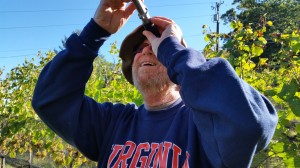
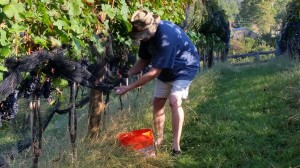
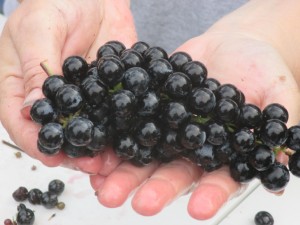
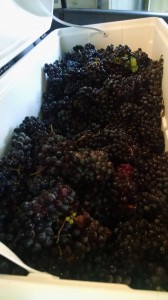
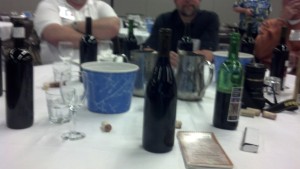
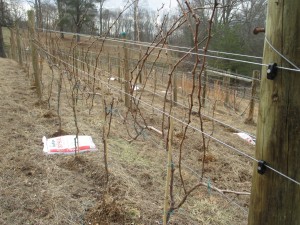
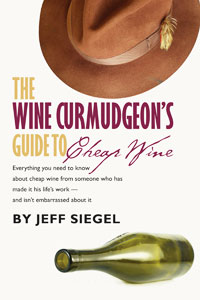
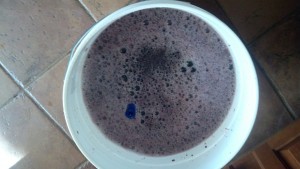
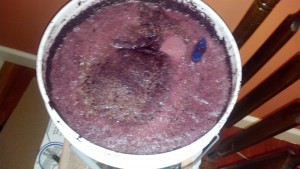
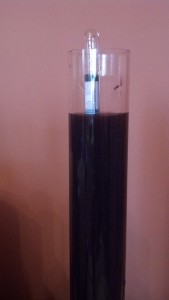
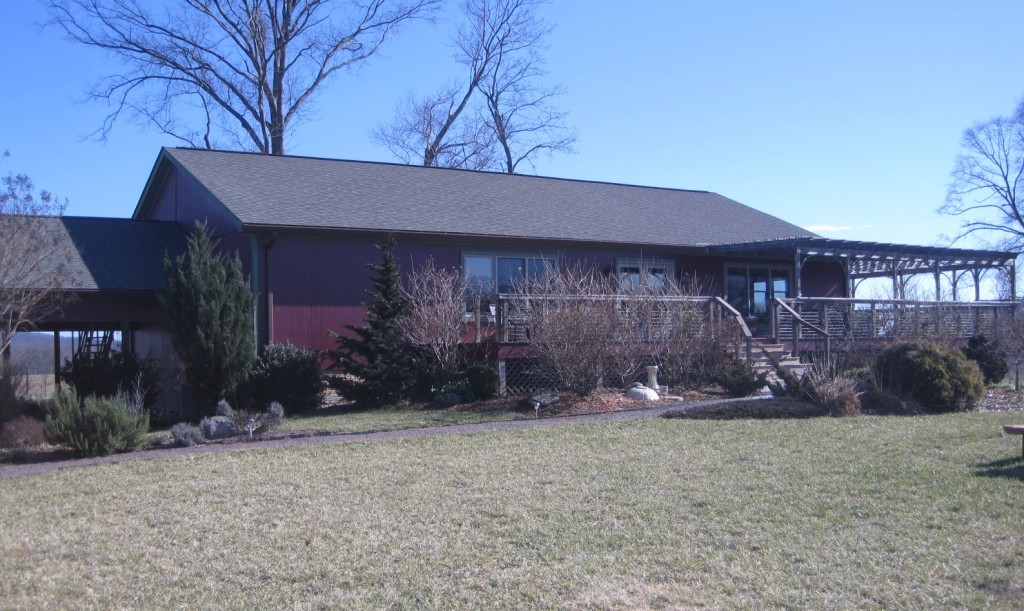
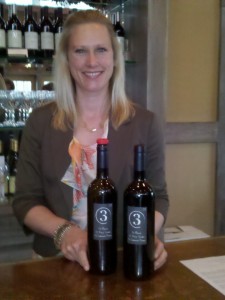


Recent Comments